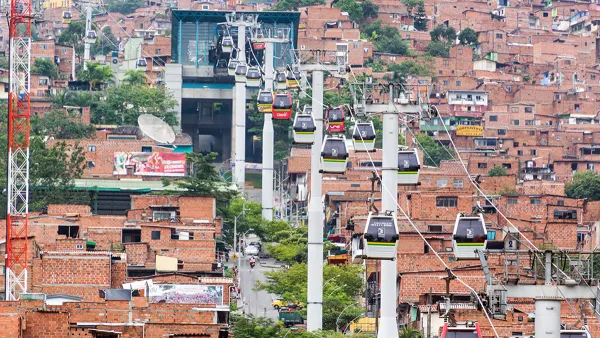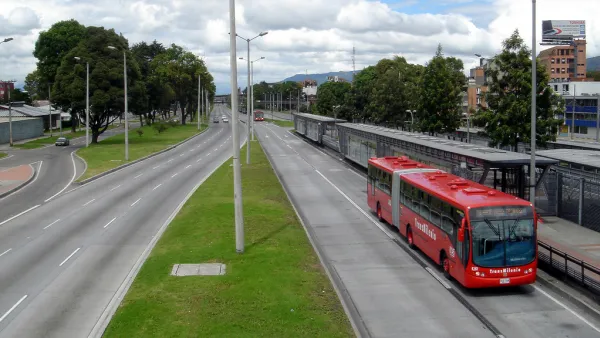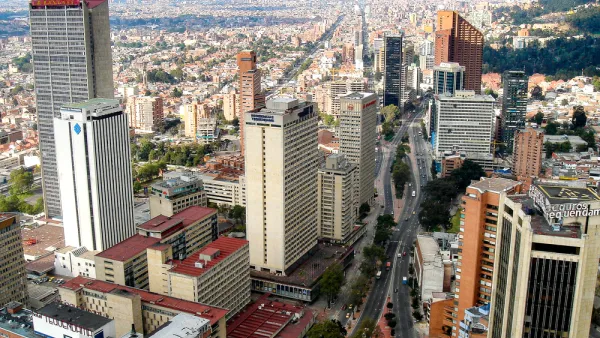The cities of Bogotá and Medellín have made dramatic transformations over the last ten years, driven in large part by their influential mayors. But while one continues to soar, the other is in crisis, reports Justin McGuirk
Two cities in Colombia showcase how the mix of politics and good infrastructure design can work. Bogota, Colombia's capital, utilized transport infrastructure to revitalize their streets. Two past mayors, Antanas Mockus and Enrique Peñalosa, "brought decent sidewalks, bike lanes and the Transmilenio bus service to bypass the capital's crippling traffic – measures that privileged the non-car-owning poor." With current overcrowding, various stalled road projects and the last mayor accused of corruption, Bogota is a city in trouble.
By comparison, Medellin was considered a dangerous city filled with violence and drugs in the 1990s. By the early to mid 2000s, progressive design projects such as Coliseos Juegos Suramericanos, Orquideorama, and Paisajes Emergentes swimming pool complex, led the city's revival, notes McGuirk.
Giancarlo Mazzanti, Colombia's renowned architect, says the focus on "social urbanism" reflected in these projects marks a critical shift in urban policy, "This is a massive U-turn since the days when it was common to speak of 'cutting out the cancer' of the slums. For once, architecture-as-spectacle is not being used as a tool to market the culture industry, but to make poverty visible."
In the hands of mayor Sergio Fajardo, Medellin became a proving ground for innovative urban design. "There are several hybrid library-parks (part community centres and part much-needed public spaces), two cable car systems and, most recently, an outdoor escalator running nearly 400m up the troubled slum of Comuna 13." Fajardo focused on the creation of public spaces for the poor and "he attributed the fall in crime during his term in part to the increase in the amount of public space per citizen."
FULL STORY: Colombia's architectural tale of two cities

National Parks Layoffs Will Cause Communities to Lose Billions
Thousands of essential park workers were laid off this week, just before the busy spring break season.

Retro-silient?: America’s First “Eco-burb,” The Woodlands Turns 50
A master-planned community north of Houston offers lessons on green infrastructure and resilient design, but falls short of its founder’s lofty affordability and walkability goals.

Delivering for America Plan Will Downgrade Mail Service in at Least 49.5 Percent of Zip Codes
Republican and Democrat lawmakers criticize the plan for its disproportionate negative impact on rural communities.

Test News Post 1
This is a summary

Test News Headline 46
Test for the image on the front page.

Balancing Bombs and Butterflies: How the National Guard Protects a Rare Species
The National Guard at Fort Indiantown Gap uses GIS technology and land management strategies to balance military training with conservation efforts, ensuring the survival of the rare eastern regal fritillary butterfly.
Urban Design for Planners 1: Software Tools
This six-course series explores essential urban design concepts using open source software and equips planners with the tools they need to participate fully in the urban design process.
Planning for Universal Design
Learn the tools for implementing Universal Design in planning regulations.
EMC Planning Group, Inc.
Planetizen
Planetizen
Mpact (formerly Rail~Volution)
Great Falls Development Authority, Inc.
HUDs Office of Policy Development and Research
NYU Wagner Graduate School of Public Service





























